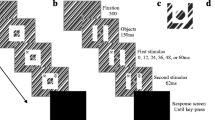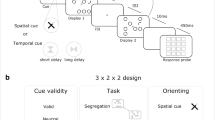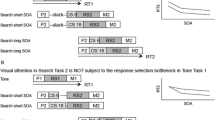Summary
Theorists from both classical structuralism and modern attention research have claimed that attention to a sensory stimulus enhances processing speed. However, they have used different operations to measure this effect, viz., temporal-order judgment (TOJ) and reaction-time (RT) measurement. We report two experiments that compared the effect of a spatial cue on RT and TOJ. Experiment 1 demonstrated that a nonmasked, peripheral cue (the brief brightening of a box) affected both RT and TOJ. However, the former effect was significantly larger than the latter. A masked cue had a smaller, but reliable, effect on TOJ. In Experiment 2, the effects of a masked cue on RT and TOJ were compared under identical stimulus conditions. While the cue had a strong effect on RT, it left TOJ unaffected. These results suggest that a spatial cue may have dissociable effects on response processes and the processes that lead to a conscious percept. Implications for the concept of direct parameter specification and for theories of visual attention are discussed.
Similar content being viewed by others
References
Allport, D. A. (1980). Attention and performance. In G. Claxton (Ed.),Cognitive psychology — new directions (pp. 112–153). London:Routledge and Kegan Paul.
Allport, D. A. (1987). Selection for action: Some behavioral and neurophysiological considerations of attention and action. In H. Heuer & A. F. Sanders (Eds.),Perspectives on perception and action (pp. 395–419). Hillsdale, NJ: Lawrence Erlbaum Associates.
Allport, D. A. (1989). Visual attention. In M. I. Posner (Ed.),Foundations of cognitive science (pp. 631–681). Cambridge, MA: MIT Press.
Bachmann, T. (1989). Microgenesis as traced by the transient pairedforms paradigm.Acta Psychologica, 70, 3–17.
Barr, M. (1983). A comparison of reaction-time and temporal-orderjudgment estimates of latency to sinusoidal gratings.Perception, 12, 7.
Boring, E. G. (1942).Sensation and perception in the history of experimental psychology. New York: Appleton-Century-Crofts.
Bridgeman, B., Kirch, M., & Sperling, A. (1981). Segregation of cognitive and motor aspects of visual function using induced motion.Perception & Psychophysics, 29, 336–342.
Eriksen, C. W., & Hoffman, J. (1972). Some characteristics of selective attention in visual perception determined by vocal reaction time.Perception & Psychophysics, 11, 169–171.
Farah, M. J. (in press). The neural bases of visual perception and visual awareness: A critical review. In. C. Umiltà, & M. Moscovitch (Eds.),Attention and performance 15: Conscious and nonconscious information processing. Cambridge, MA: MIT Press.
Frey, R. D. (1990). Selective attention, event perception and the criterion of acceptability principle: Evidence supporting and rejecting the doctrine of prior entry.Human Movement Science, 9, 481–530.
Jacoby, L. L. (1991). A process dissociation framework: Separating automatic from intentional uses of memory.Journal of Memory and Language, 30, 513–541.
Jacoby, L. L. (in press). Strategic vs. automatic influences of associative context: Process dissociations. In C. Umiltà, & M. Moscovitch (Eds.),Attention and performance 15: Conscious and nonconscious information processing. Cambridge, MA: MIT Press.
Mayzner, M. S., & Tresselt, M. E. (1970). Visual information processing with sequential inputs: A general model for sequential blanking, displacement, and overprinting phenomena.Annals of the New York Academy of Sciences, 169, 599–618.
McClelland, J. L. (1978). Perception and masking of wholes and parts.Journal of Experimental Psychology: Human Perception and Performance, 4, 210–223.
Neumann, O. (1980). Informationsselektion und Handlungssteuerung. Untersuchungen zur Funktionsgrundlage des Stroop-Interferenzphänomens. Unpublished doctoral thesis, Ruhr University, Bochum, Germany.
Neumann, O. (1982). Experimente zum Fehrer-Raab-Effekt und das Wetterwart-Modell der visuellen Maskierung.Bericht Nr. 24/1982, Psychologisches Institut der Ruhr-Universität Bochum, Arbeitseinheit Kognitionspsychologie.
Neumann, O. (1987). Beyond Capacity: A functional view of attention. In H. Heuer & A. F. Sanders (Eds.),Perspectives on perception and action (pp. 361–394). Hillsdale, NJ: Lawrence Erlbaum Associates.
Neumann, O. (1989). Kognitive Vermittlung und direkte Parameterspezifikation. Zum Problem mentaler Repräsentation in der Wahrnehmung.Sprache und Kognition, 8, 32–49.
Neumann, O. (1990a). Direct parameter specification and the concept of perception.Psychological Research, 52, 207–215.
Neumann, O. (1990b). Visual attention and action. In O. Neumann & W. Prinz (Eds.),Relationships between perception and action: Current approaches (pp. 227–267). Berlin, Heidelberg, New York, Tokyo: Springer.
Neumann, O. (1992a). Theorien der Aufmerksamkeit: Von Metaphern zu Mechanismen.Psychologische Rundschau, 43, 1–19.
Neumann, O. (1992b). Konzepte der Aufmerksamkeit. Entstehung, Wandlungen und Funktionen eines psychologischen Begriffs. Habilitationsschrift, Ludwig-Maximilians-Universität München.
Neumann, O. (in press). Theorien der Aufmerksamkeit: Zurück in die fünfziger Jahre? Erwiderung auf Schulz (1993).Psychologische Rundschau
Neumann, O., & Klotz, W. (in press). Motor responses to nonreportable, masked stimuli: Where is the limit of direct parameter specification? In C. Umiltà, & M. Moscovitch (Eds.),Attention and performance 15: Conscious and nonconscious information processing. Cambridge, MA: MIT Press.
Neumann, O., Koch, R., Niepel, M., & Tappe, Th. (1993). Reaktionszeit und zeitliches Reihenfolgeurteil: Übereinstimmung oder Dissoziation?Zeitschrift für experimentelle und angewandte Psychologie, 39, 621–645.
Neumann, O., Niepel, M., Tappe, Th., & Koch, R. (under revision). Temporal order judgment and reaction time to visual and auditory stimuli of different intensities: Further evidence for dissociations. Perception & Psychophysics
Neumann, O., Tappe, Th., & Niepel, M. (submitted). The effect of stimulus intensity and sensory modality on reaction time and temporal order judgment: A survey and an appraisal.
Posner, M. I. (1980). Orienting of attention.Quarterly Journal of Experimental Psychology, Section A, 32, 3–25.
Posner, M. I., Nissen, M. J., & Ogden, W. C. (1978). Attended and unattended processing modes: The role of set for spatial location. In H. I. Pick & E. Saltzman (Eds.),Modes of perceiving and processing information (pp. 137–157). Hillsdale, NJ: Lawrence Erlbaum Associates.
Posner, M. I., Snyder, C. R. R., & Davidson, B. J. (1980). Attention and the detection of signals.Journal of Experimental Psychology: General, 109, 160–174.
Rutschmann, R., & Link, R. (1964). Perception of temporal order of stimuli differing in sense mode and simple reaction time.Perceptual and Motor Skills, 18, 345–352.
Sternberg, S., & Knoll, R. L. (1973). The perception of temporal order: Fundamental issues and a general model. In S. Kornblum (Ed.),Attention and performance 4 (pp. 629–685). New York: Academic Press.
Sternberg, S., Knoll, R. L., & Zukofsky, P. (1982). Timing by skilled musicians. In D. Deutsch (Ed.),The psychology of music (pp. 181–239). New York: Academic Press.
Stelmach, L. B., & Herdman, Ch. M. (1991). Directed attention and perception of temporal order.Journal of Experimental Psychology: Human Perception and Performance, 17, 539–550.
Tappe, Th., Niepel, M., & Neumann, O. (in press). A dissociation between reaction time to sinusoidal gratings and temporal order judgment.Perception.
Titchener, E. B. (1908).Lectures on the elementary psychology of feeling and attention. New York: MacMillan.
Treisman, A. (1988). Features and objects: The fourteenth Bartlett memmorial lecture.Quarterly Journal of Experimental Psychology, 40A, 201–237.
Treisman, A. (1992). Visual attention and the perception of objects.International Journal of Psychology, 27, 13.
Treisman, A., & Gelade, G. (1980). A feature-integration theory of attention.Cognitive Psychology, 12, 97–136.
Ulrich, R. (1987). Threshold models of temporal order judgments evaluated by a ternary response task.Perception & Psychophysics, 42, 224–239.
Van der Heijden, A. H. C. (1990). Visual information processing and selection. In O. Neumann & W. Prinz (Eds.),Relationships between perception and action: Current approaches (pp. 203–226). Berlin, Heidelberg, New York, Tokyo: Springer.
Van der Heijden, A. H. C. (1992).Selective attention in vision. London & New York: Routledge and Kegan Paul.
Weiskrantz, L. (1988). Some contributions of neuropsychology of vision and memory to the problem of consciousness. In A. J. Marcel & E. Bisiach (Eds.),Consciousness in contemporary science. Oxford: Clarendon Press.
Weisstein, N. (1971). W-shaped and U-shaped functions obtained for monoptic and dichoptic disk-disk masking.Perception & Psychophysics, 9, 275–278.
Wolff, P. (1977). Entnahme der Identitäts- und Positions-Information bei der Identifikation tachistoskopischer Buchstabenzeilen. Ein theoretischer und experimenteller Beitrag zur Grundlagenforschung des Lesens. Unpublished doctoral dissertation, Ruhr University, Bochum, Germany.
Author information
Authors and Affiliations
Rights and permissions
About this article
Cite this article
Neumann, O., Esselmann, U. & Klotz, W. Differential effects of visual-spatial attention on response latency and temporal-order judgment. Psychol. Res 56, 26–34 (1993). https://doi.org/10.1007/BF00572130
Issue Date:
DOI: https://doi.org/10.1007/BF00572130




